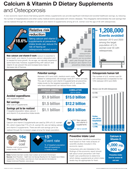 Washington, D.C., December 9, 2014—With the new year and accompanying resolutions fast-approaching, women of all ages should consider recommitting to calcium and vitamin D supplements, particularly if they have concerns about osteoporosis. A new economic report, conducted by Frost & Sullivan through a grant from the Council for Responsible Nutrition Foundation (CRNF), showed that the utilization of calcium and vitamin D supplements in a population of women over the age of 55 with osteoporosis can provide significant individual and societal health care savings. This is because taking calcium and vitamin D at preventive intake levels can reduce the risk of having an osteoporosis-related medical event, according to the report, “Smart Prevention – Health Care Cost Savings Resulting from the Targeted Use of Dietary Supplements.”
Washington, D.C., December 9, 2014—With the new year and accompanying resolutions fast-approaching, women of all ages should consider recommitting to calcium and vitamin D supplements, particularly if they have concerns about osteoporosis. A new economic report, conducted by Frost & Sullivan through a grant from the Council for Responsible Nutrition Foundation (CRNF), showed that the utilization of calcium and vitamin D supplements in a population of women over the age of 55 with osteoporosis can provide significant individual and societal health care savings. This is because taking calcium and vitamin D at preventive intake levels can reduce the risk of having an osteoporosis-related medical event, according to the report, “Smart Prevention – Health Care Cost Savings Resulting from the Targeted Use of Dietary Supplements.”
“As much as we don’t like it, part of aging is accepting naturally occurring changes, such as bone loss,” said Duffy MacKay, N.D., senior vice president, scientific and regulatory affairs, Council for Responsible Nutrition. “Supplementing with calcium and vitamin D is smart prevention for aging gracefully.”
The economic report explained that calcium and vitamin D supplements are already being used by 29 percent of U.S. women over the age of 55, which would mean that between 2013 and 2020 there is the possibility of over $12 billion in health care cost savings. With 71 percent of this population not taking calcium and vitamin D supplements, however, there are still billions of dollars more in savings yet to be realized, according to the report.
“We’ve come to understand that significant amounts of money are already being saved due to the responsible health choices women are making in taking dietary supplements. But there’s a real opportunity out there to save even more money—billions of dollars—and, in the process, help even more women at risk of experiencing a painful and expensive fracture,” said Steve Mister, president, CRNF.
To achieve the results, Frost & Sullivan conducted a systematic review of scientific studies that focused on studies that looked at the relationship between calcium and vitamin D supplementation and the risk of an osteoporosis-attributed event. The firm then projected the rates of osteoporosis-attributed medical events across U.S. women over the age of 55 with osteoporosis and applied a cost benefit analysis to determine the cost savings if people in this targeted population took calcium and vitamin D supplements at preventive intake levels.
The full Frost & Sullivan economic report and accompanying materials, including a calcium and vitamin D infographic, are available for free at www.supplementforsmartprevention.org.

